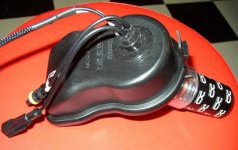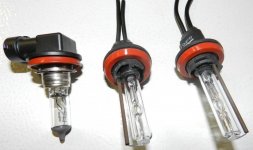More RT622 Trailer Mods
Actually, it's a continuation of 104-113---
http://www.spyderlovers.com/forums/showthread.php?24907-Phil-s-Mods&p=382934&viewfull=1#post382934
The thought hit me that I might need light inside the trailer, if it is disconnected from the bike. I have the great halo of bright white LEDs, now how do I make that happen.....
STUFF:
1. Battery
2. Some simple way to take the battery in and out.
3. Diode to make sure the trailer battery is charged from the bike, but it doesn't power the bike!
I'm going to try to do a schematic of all this, but for now we'll use pics and description.
The trailer electrical is really very simple.
Post #110 shows the 4 wires that we have. Of them, only the +12v and Ground are the ones we're concerned with. I started under the trailer to see where the wires entered the trailer body-
Not hard to see that here is where the wires transition into the trailer.
Peeling back the carpet, we see the entry point.
I also peeled back some of the plastic wire aromor so I could reveal the brown, +12v line. Remember that this is +12v that comes from the bike via the connector. Here you can also see that I've cut the brown +12v wire where I'm adding a diode.
Think of a diode as a one way valve. As in water, a one way valve only lets water flow one way, a diode allows electrons (electricity) to flow one way. Putting the diode right here, allows us to power the trailer from it's own battery and prevents that power from going back to the bike. At the same time, power from the bike will flow to the trailer to power the lights AND, if I want, charge the trailer battery. Good for safety and general good electrical principals. I left the wires long just to make things easier to see.....
Notice, I used an inline fuse holder. It really works well. Here's a closeup of the diode...
You can see I simply press fit it into the holder. If you do this, you'll want the white line on the diode on the 'output' side of the diode. Think of it like an arrow pointing to the direction of the electron flow. The diode is from Radio Shack and is good for about 3 amps. Here's an IMPORTANT STEP. Guaranteed you will forget that you have added a diode in a fuse holder! So, mark it....
Here's the pretty much finished diode project----
I've taped a spare diode in it's plastic bag next to the diode that's in use. Again... I'll forget and some day if I ever need a spare... there it is! The body of the trailer is fiberglass so it makes doing electrical work pretty easy, not having to worry about exposed wires, but still I try to use good practice to make sure everything is protected against wire chafing.
On to the battery.....
I selected this battery mostly because of its size. It's 12AH (meaning I can power all of my trailer LEDs, 2 amps) for about 6 hours without a recharge. I ALWAYS like to have a main fuse close to the battery. I also wanted a simple disconnect for the battery. AND... I wanted a way to hook it to a battery tender to top it off. Here's the result......
Notice, I've used heat shrink everywhere and I've removed stress from the battery terminals using a 'staycon pad' plus tie wrap. I've also terminated it in a female 12v accessory jack. Use the female jack here for several reasons: Safer since it's really hard to short the connection; makes it REALLY simple to connect to my existing battery tender; allows the rig to be used just like an accessory outlet, if needed.
Here's the finished project mounted in the trailer---
Notice on the left, plugged into the female accessory outlet is a male plug. Again, Radio Shack. The other end of the plug is attached to the main +12v line in the trailer and the Ground. That plug also has a switch and green LED. This is a simple master power and reminder! Keeping the battery in place is all Velcro. I've added a large section of the hook side to the bottom and the back of the battery. To make it even more snug, I added the strips that you see around the middle of the battery. It's rock solid!
Next, I'm going to add a separate hard switch to turn the white LEDs on/off without needing the remote. Easy to do, but I just didn't get to it yet

.














